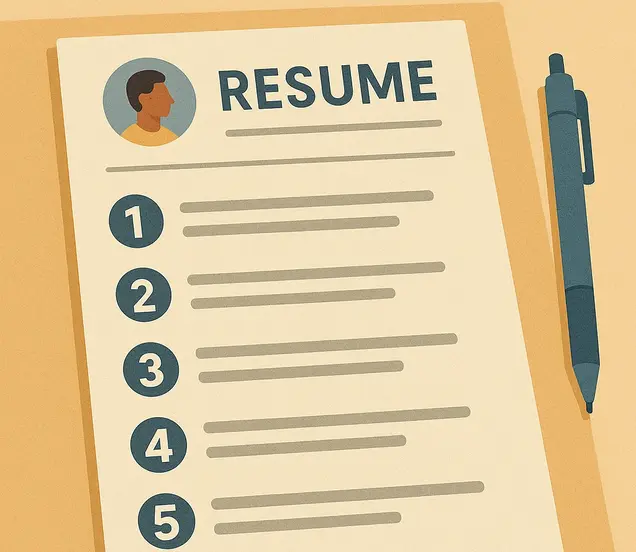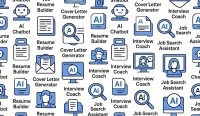Landing the first interview is the hardest part—and a surprising amount of failure comes from resume design, not your experience. Studies of more than 100,000 resumes, eye‑tracking research on how recruiters actually scan pages, and hiring leaders from Amazon, Netflix, Meta, and high‑growth startups converge on five principles. Apply them and you move from plausible to compelling.
1) Show, Don’t Tell (Quantify Outcomes)
Numbers beat adjectives. Specific metrics make you markedly more likely to get interviews because they prove impact, break up text, and signal you know how to measure success. Use a simple pattern: what you achieved, how it was measured, and how you did it.
PM example: Led launch of two pricing tiers lifting signups 75% by running pricing research and A/B tests—driving $29M incremental revenue.
Engineer example: Raised Android test coverage 80%, cutting user bug reports 50% and crash rate 35% through CI hardening and flaky test triage.
Marketer example: Built spring campaign that beat prior year sales 60% by iterating creative with sales feedback and reallocating spend to high‑ROAS channels.
If you truly lack a metric, use objective signals (awards, customers won, time‑to‑market) and add timeframes to anchor credibility.
2) Be Concise (500–600 Words, 1–2 Pages)
Recruiters spend seconds, not minutes. Overstuffed resumes get skimmed and skipped. Keep to roughly 500–600 words across one page early career, two pages for senior leaders. Your goal is not autobiography—it’s making your top three outcomes per role impossible to miss. White space and scannable bullets help; dense paragraphs don’t.
3) Prioritize For The F‑Pattern Scan
Eye‑tracking shows readers skim down the left for companies and titles, then across the top few words of bullets, reading less as they go. Left‑align company and title, bold them, and front‑load each bullet with the hook that stops the scan: either the outcome or the metric first.
Hook patterns: “Launched X, resulting in…”, “Improved Y by Z% by…”, or metric‑first (“Cut churn 22% by…”). Give your most recent roles three to four bullets, older roles one to two. Use a one‑line company primer if the brand is unknown (e.g., “Tabby — $1.5B BNPL platform”). Keep visuals minimal; ornate templates, tables, and columns distract and can break ATS parsing.
4) Cut Fluff And Passive Filler
Delete buzzwords, cliches, adverbs, and self‑ratings. Replace “team player,” “detail‑oriented,” “successfully implemented” with evidence. Avoid personal pronouns and excessive “assisted/collaborated” framing; prefer leadership verbs tied to outcomes.
Weak: “Successfully implemented analytics platform.”
Strong: “Implemented Amplitude, enabling weekly product reviews and lifting activation 18% in two quarters.”
Weak: “Collaborated on migration.”
Strong: “Led cross‑functional cutover to GCP with zero downtime, reducing infra cost 26%.”
5) Use The Right Amount Of Keywords (In Context)
Keywords matter for both humans and ATS—but stuffing hurts readability. Map the job description and meet the core 50–60% of requirements with real evidence. Place skills where they’re believable: a lean skills line, a final bullet listing principal tools used in each job, and keywords embedded inside outcome bullets.
PM: “Improved trial‑to‑paid 24% using Mixpanel cohorts, Amplitude funnels, and pricing tests in LaunchDarkly.”
Engineer: “Shipped gRPC services in Go on GKE; introduced OpenTelemetry and reduced p95 latency 40%.”
Marketer: “Scaled Meta/Google/TT spend 3× while holding CAC, optimized through PMAX/Advantage+ and first‑party audiences.”
Remember: most offers flow through networks. Keywords get you parsed; relationships get you seen.
Role‑Specific Tweaks (PM, Engineer, Marketer)
Product Manager
- Prioritize business outcomes and decision quality: revenue, margin, retention, CAC/LTV.
- Show strategy artifacts (PRDs, roadmaps, bet frameworks) and the trade‑offs you made.
- Evidence user insight: research volume/methods and decisions changed by findings.
Software Engineer
- Lead with reliability and user impact: latency, availability, cost, security posture.
- Map stack clearly (languages/frameworks/infra) tied to shipped features and SLAs.
- Call out platform leverage: tooling that boosted throughput or cut incidents.
Marketer
- Anchor to funnel metrics: impression → CTR → CVR → CAC → LTV; name channels and budgets.
- Differentiate paid vs. lifecycle vs. brand; show testing velocity and creative iterations.
- Tie brand work to measurable lifts (search volume, branded CVR, share of voice).
Before → After Bullets
- PM: “Managed roadmap.” → “Sequenced 4 bets to lift ARR 18% in 12 months; sunset 2 features (<2% usage) to reallocate 3 FTEs.”
- Engineer: “Wrote microservices.” → “Delivered 5 Go services on GKE; cut p95 from 640ms→380ms and errors 0.9%→0.3%.”
- Marketer: “Ran campaigns.” → “Scaled TT spend 2.4× while holding CAC; improved CVR 31% via creative v6 informed by 40 customer calls.”
Role-Specific Tweaks That Get Results
Every role demands a different kind of proof. Product Managers show outcomes and decisions. Engineers show reliability and leverage. Marketers show measurable growth. Clarity, metrics, and progression turn bullet points into evidence — and evidence gets interviews. Don’t just describe work — quantify impact.
Post Jobs & Find High-Impact Talent →Putting It Together (A Mini Blueprint)
Top: name, role target, city, contact, LinkedIn/GitHub/portfolio.
Experience (reverse‑chronological): bold company and title, brand primer if needed, three to four bullets for recent roles, each with quantified outcomes.
Education/certifications: concise, recent only.
Skills: tight, current, role‑relevant.
If you fold the page to show only the left third, would a recruiter still want to meet you? If not, rewrite the hooks.
Quick Pre‑Submit Checklist
- Each recent role has 3–4 quantified outcomes; older roles 1–2.
- Left‑aligned, bolded companies/titles; clean single column; no tables.
- ~500–600 words; ample white space; hooks front‑loaded.
- Keywords embedded in context; skills list is lean and current.
- One line clarifies unknown companies; metrics are time‑bound and credible.
Frequently Asked Questions
Do I need two pages?
Early career: one page. Senior roles: two pages are fine—if every line earns its keep.
Should I use a summary?
Optional. If it flags a marquee brand/result that isn’t recent, keep it to one line.
Are templates okay?
Use clean, single‑column layouts that parse well. Prioritize content over style.
How many versions should I have?
One master; tailor 2–3 bullets and keywords per application to mirror the JD’s priorities.
Do I include side projects or open source?
Yes—if they demonstrate role‑relevant impact. Treat them like experience: outcome → metric → how.
What about GPA or certifications?
List GPA only early career and only if strong. Certifications help when tied to concrete results.
Should I add a skills table at the top?
Avoid dense tables. Use a concise skills line and show tools inside impact bullets for credibility.




